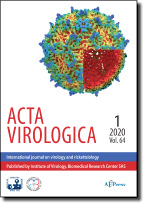Acta Virologica Vol.59, No.3, p.305-310, 2015
|
| Title: Spectrum of VP1 region genetic variants in the foot-and-mouth disease virus serotype O populations derived from infected cattle tongue epithelium |
| Author: L. N. SARANGI, J. K. MOHAPATRA, S. SUBRAMANIAM, L. K. PANDEY, B. DAS, A. SANYAL, J. MISRI, B. PATTNAIK |
|
Abstract: RNA virus population exists as a complex distribution of non-identical but closely related sequences known as viral quasispecies. Variant strains are selected from this quasispecies population in response to changing environment. The quasispecies dynamics of a virus existing within an infected host differs from that in a cell culture-adapted population. This study was carried out to explore the genetic variations present in the VP1 coding region of the foot-and-mouth disease (FMD) virus serotype O derived directly from infected cattle tongue epithelium. Molecular clonal populations of two serotype O strains belonging to lineages Ind2001 (IND 30/2011) and PanAsia2 (IND 5/2011) were sequenced at VP1 coding region. For IND 30/2011, 19 clones were sequenced and analysis showed variations at 12 nucleotide positions (nt) resulting in 8 amino acid (aa) replacements. Similarly, for IND 5/2011 virus, 18 clones were sequenced, of which six showed nt variations leading to 3 aa replacements. Most of the variable positions mapped to the surface-exposed loops and some of them were found in the neutralizing antigenic sites (position 81, 149, 169, 186 and 202 of IND 30/2011 and 141 of IND 5/2011), which potentially could be beneficial in rapid adaptive evolution of the virus by giving rise to antigenic variants to overcome neutralizing antibodies. These findings encourage further research into the landscape of the viral quasispecies population in vivo and its implication for viral ecology.
|
|
| Keywords: foot-and-mouth disease virus; VP1 region; variants in vivo |
|
|
|
| Year: 2015, Volume: 59, Issue: 3 |
Page From: 305, Page To: 310 |
doi:10.4149/av_2015_03_305
|
|
 download file download file |
|
|
|
|
 download file
download file
